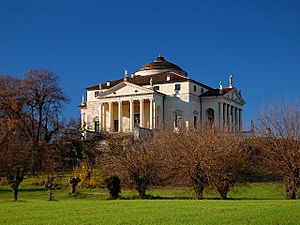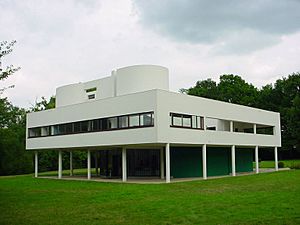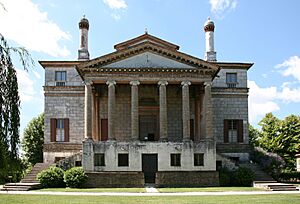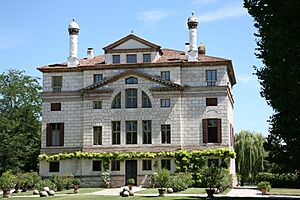Colin Rowe facts for kids
Colin Rowe (born March 27, 1920 – died November 5, 1999) was a British-born expert on architecture. He later became an American citizen. He was a very important thinker, critic, and teacher in the world of architecture and city planning during the second half of the 1900s.
Colin Rowe taught at the University of Texas at Austin and the University of Cambridge in England for short periods. For most of his life, he was a professor at Cornell University in Ithaca, New York. Many of his students became famous architects. They helped spread his ideas throughout the architecture and planning fields. In 1995, he received the Gold Medal from the Royal Institute of British Architects. This is their highest award. He also received the Athena Medal in 2011 after his death.
Contents
Early Life and Studies
Colin Frederick Rowe was born in Rotherham, England, in 1920. His father was a schoolteacher. Colin earned a scholarship to a local grammar school. He later studied architecture at the University of Liverpool.
In December 1942, he joined the Royal Air Force for military service. He hurt his spine badly during a practice parachute jump. He had to stay in the hospital for over six months.
New Ways of Thinking About Architecture
Colin Rowe had a very original way of looking at architectural history. He liked to compare different cultural events and buildings that historians usually kept separate. He would put them side-by-side to find new connections. This unusual way of looking at history helped him create new ideas.
One of his most famous ideas was in his essay "The Mathematics of the Ideal Villa" (1947). In this essay, he suggested that there were hidden "rules" in the designs of old villas by Palladio. He believed these rules were similar to those found in modern villas by Le Corbusier. Even though he couldn't prove this with facts, his idea allowed him to compare these buildings in a fresh way. He looked at them as if they existed side-by-side in the present, not just in their own time.
This new approach helped people see modern architecture as part of a longer history. It showed that the past still influenced new designs. Many important architects in the late 20th century, like James Stirling, Robert Venturi, and Peter Eisenman, were influenced by Rowe's ideas. They started to use history in their own designs.
Teaching and Important Writings
Colin Rowe taught at the Liverpool School of Architecture between 1950 and 1952. There, he influenced a young student named James Stirling. Rowe believed that modern architecture had not fully succeeded. He saw Stirling as a way to create a new kind of "modernist neo-classicist" architect. They became lifelong friends. Stirling's architectural work was greatly shaped by Rowe's ideas.
From the 1950s until his death, Rowe wrote many influential papers. These writings explored the idea that modern architecture and traditional styles, especially Classicism, were connected. He admired the work of early modern architects like Le Corbusier. However, he also criticized the modern movement, believing it had some failures.
Rowe was one of the first to speak out against the problems of modern city planning. He believed it often harmed historic cities. His early work led to the idea of contextualism. This is a way of designing new buildings so they fit well with the existing style of a traditional city.
Rowe taught at Cornell University from 1962 until he retired in 1990. He focused on developing a new way to design cities. This method involved putting together different ideas and pieces, like a collage. He saw the ruined villa of the Roman Emperor Hadrian as a perfect example of this approach.
His book Collage City (written with Fred Koetter) is a key work. In it, he looked at successful cities and showed how they were built up over time. They were like a "collage" of many different ideas from different generations. In architecture, he believed that modern buildings should not be too simple. Instead, they should be influenced by historical styles.
Colin Rowe became a permanent resident of the United States and later a US citizen. He continued to influence many architects, students, and teachers. He was partly connected to Postmodern architecture. However, his wide interest in all styles of architecture meant he didn't fit into just one category. Rowe passed away on November 5, 1999, at age 79.
"The Mathematics of the Ideal Villa" Explained
Colin Rowe's important essay, "The Mathematics of the Ideal Villa," was printed many times. In this essay, Rowe presented his unique idea of directly comparing modern and old (neo-Classical) architecture. This was a new idea at the time, as most architectural writers did not do this.
Rowe compared a villa by Le Corbusier to a villa by Andrea Palladio from the 1500s. He chose Palladio's Malcontenta (Villa Foscari) and Le Corbusier's villa at Garches. Rowe argued that both buildings were similar in size and shape. He noted that both houses showed a similar pattern of spaces and supports.
Rowe concluded that Palladio focused on a logical arrangement of accepted ideas. Le Corbusier, on the other hand, compared new systems with old ones. Rowe also discussed how both Le Corbusier's Villa Savoye and Palladio's Villa Rotonda shared a love for mathematical design.
In his famous closing words, Rowe praised both Palladio and Le Corbusier. He said that their original works were magnificent. He believed they had a more lasting impact on the "mathematics of the ideal villa" than most of their followers.
Selected Works
- The Architecture of Good Intentions (1994)
- As I Was Saying: Recollections and Miscellaneous Essays, collected essays, letters, and papers in 3 volumes by MIT Press (1999), ISBN: 978-0262681100
- I Almost Forgot: Unpublished Colin Rowe, edited by Daniel Naegele. The MIT Press (2023), ISBN: 9780262047128
- "The Present Urban Predicament" in The Cornell Journal of Architecture, no.1, 1981
- "Roma Interrotta" in Architectural Design Profile, Vol. 49, No. 3-4 (1979)
- Collage City (1978) with Fred Koetter
- The Mathematics of the Ideal Villa and Other Essays (1976)
- "Transparency: Literal and Phenomenal" Part II, Perspecta 13/14, 1971
- Italian Architecture of the 16th Century, with Leon Satkowski, Princeton Architectural Press, 2002, ISBN: 1-56898-331-X
See also
- The Texas Rangers





